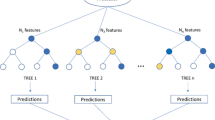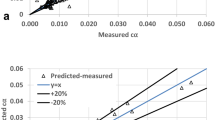Abstract
This paper presents new attempts to explore the dependency of some key geotechnical properties of soils such as compaction characteristics, hydraulic conductivity, and soil shear strength to their index properties and performance of developed models to predict these properties. To do this, a database of 580 data sets was compiled including the results of grain size distribution, Atterberg limits, compaction, and permeability, measured at different levels of compaction degree (90 to 100 %) as well as consolidated-drained triaxial compression tests. Dependency of each geotechnical property to their index parameters was investigated using an Evolutionary polynomial regression method, to develop prediction models based on the collected database. Investigation of the performance of the developed models indicates that these models are capable of predicting these soil properties with a confidence interval of 95 %. Parametric analyses were also performed on the developed models.













Similar content being viewed by others
References
Ahangar-Asr A, Faramarzi A, Mottaghifard N, Javadi AA (2011) Modeling of permeability and compaction characteristics of soils using evolutionary polynomial regression. Comput Geosci 37(11):1860–1869
ASTM D-1557. (2012). Standard Test Methods for Laboratory Compaction Characteristics of Soil Using Modified Effort.
ASTM D-698. (2012). Standard Test Methods for Laboratory Compaction Characteristics of Soil Using Standard Effort.
Bjerrum L, Huder J (1957) Measurement of the permeability of compacted clays. In: Proceedings, Fourth International Conference on Soil Mechanics and Foundation Engineering, Vol. 1, London, England., pp 6–10
Boadu, F. K. (2000). Hydraulic conductivity of soils from grain-size distribution. Journal of Geotechnical and Geoenvironmental Engineering, Vol. 126, No. 8.
Boutwell, G., and C. Hedges. (1989). Evaluation of waste retention liners by multivariate statistics. Proceeding 12th International Conference on Soil Mechanics and Foundation Engineering. Rio de Janeiro. 815–818
Boynton SS, Daniel ED (1985) Hydraulic conductivity of compacted clay. J Geotech Eng 111(4):465–478
Burmister, D. M. (1954). Principles of permeability testing of soils. ASTM Symposium on Permeability of Soils, ASTM Special Technical Publication No. 163
Carman PC (1937) Fluid flow through granular beds. Trans Inst Chem Eng 15:150
Chapuis RP (2004) Predicting the saturated hydraulic conductivity of sand and gravel using effective diameter and void ratio. Can Geotech J 41(5):787–795
Cote J, Fillion MH, Konrad JM (2011) Estimating hydraulic and thermal conductivity of crushed granite using porosity and equivalent particle size. J Geotech Geoenviron Eng ASCE 137(9):834–842
Daniel, D. E. (1984). Predicting the hydraulic conductivity of compacted clay liners. Journal of Geotechnical Engineering, ASCE, Vol. 110, No. 2, 1984, pp. 285–300.
Daniel DE, Benson CH (1990) Water content-density criteria for compacted soil liners. J Geotech Eng 116(12):1811–1830
Daniel DE, Wu YK (1993) Compacted clay liners and covers for arid sites. J Geotech Eng 119(2):223–237
Davidson, D.T., and Gardiner, W.F. (1949). Calculation of standard proctor density andnoptimum moisture content from mechanical analysis, shrinkage factors, and plasticity index. In: Proceedings of the HRB29, pp.447–481.
Dixon ND, Jones RV (2005) Engineering properties of municipal solid waste. Original Research Article Geotextiles and Geomembranes 23(3):205–233
Du YJ, Shen SL, Liu SY, Hayashi S (2009) Contaminant mitigating performance of Chinese standard municipal solid waste landfill liner systems. Geotext Geomembr 27(3):232–239
Elsbury B, Daniel D, Sraders G, Anderson D, ASCE (1990) Lessons learned from compacted clay liner. J Geotech Engrg 116(11):1641–1660
Giustolisi, O., and Savic, D.A. (2006). A symbolic data-driven technique based on evolutionary polynomial regression. Journal of Hydroinformatics, IWA-IAHR Publishing, UK 8 (3), 207–222
Hazen A, ASCE (1911) Discussion of ‘Dams on Sand Foundations’ by A. C. Koenig. Transactions 73:199–203
Hermann, J. G., and Elsbury, B. R. (1987). Influential factors in soil liner construction for waste disposal facilities. In Geotechnical Practice for waste disposal’87, ASCE press, 522–536. R. D.Woods, Ed. ASCE.
Jumikis, A.R. (1946). Geology and soils of the Newark metropolitan area. Journal of the Soil Mechanics and Foundations Division, ASCE 93(SM2), 71–95.
Kayadelen C, Gu¨naydın O, Fener M, Demir A, Zvan O A (2009) A modeling of the angle of shearing resistance of soils using soft computing systems. Expert Syst Appl 36:11814–11826
Koltermann CE, Gorelick SM (1995) Fractional packing model for hydraulic conductivity derived from sediment mixtures. Water Resour Res 31:3283–3297
Lambe, T.W. (1951) Soil testing for engineers. Wiley, New York, pp. 151–158.
Michaell, A.S., Lin, C.S. (1954). The permeability of kaolinite. Industrial and Engineering Chemistry, Vol.46.
Mitchell, J.K., Hopper, D.R., and Campanella, R. C. (1965). Permeability of compacted clay. Journal of the Soil Mechanics and Foundations Division, ASCE, Vol. 91, No. SM4.
Mousavi SM, Alavi AH, Mollahasani A, Gandomi AH, Arab Esmaeili M (2011) Formulation of soil angle of shearing resistance using a hybrid GP and OLS method. Eng Comput. doi:10.1007/s00366-011-0242-x
Nagaraj, T.S. (1994). Analysis and prediction of compaction characteristics of soils, Unpublished
Oakley, R. E. (1987). Design and performance of earth-lined containment systems. In Goetechnical Practice for waste disposal’87, Gotechnical Special Publication 13, R. D.Woods, Ed. ASCE.
Olsen HW (1962) Hydraulic flow through saturated clays. Clay Clay Miner 9:131–161
Ramiah BK, Viswanath V, Krishnamurthy HV (1970) Interrelationship of compaction and index properties. Proceedings of the Second South East Asian Conference on Soil Engineering, Singapore, In, pp 577–587
Rezania M, Javadi AA, Giustolisi O (2008) An evolutionary-based data mining technique for assessment of civil engineering systems. Journal of Engineering Computations 25(6):500–517
Ring GW, Sallgerb JR, Collins WH (1962) Correlation of compaction and classification test data. HRB Bulletin 325:55–75
Rowan HW, Graham WW (1948) Proper compaction eliminates curing period in construction fills. Civ Eng 18:450–451
Sezer A (2013) Simple models for the estimation of shearing resistance angle of uniform sands. Neural Comput & Applic 22(1):111–123
Sinha SK, Wang MC (2008) Artificial neural network prediction models for soil compaction and permeability. Geotech Eng 26(1):47–64
Tizpa P, Jamshidi CR, Karimpour Fard M, Machado LS (2014) ANN prediction of some geotechnical properties of soil from their index parameters. Arab J Geosci. doi:10.1007/s12517-014-1304-3
Turnbull JM (1948) Computation of the optimum moisture content in the moisture density relationship of soils. In: In: Proceedings of the Second International Conference on Soil Mechanics and Foundation Engineering, Rotterdam, Holland., pp 256–262
United State Environmental Protection Agency (EPA). (1988). Seminars-Requirements for Hazardous Waste Landfill Design, Construction and Closure, CERI-88-33
Wang MC, Huang CC (1984) Soil compaction and permeability prediction models. J Environ Eng 110(6):1063–1083, ASCE
Zunker, F. (1930). Das verhalten des bodens zum wasser. Handbuch der bodenlehre, Vol. 6
Acknowledgments
The database used in this research has been mainly obtained from the geotechnical engineering laboratory at the Federal University of Bahia (UFBA), which is gratefully acknowledged.
Author information
Authors and Affiliations
Corresponding author
Rights and permissions
About this article
Cite this article
Jamshidi Chenari, R., Tizpa, P., Ghorbani Rad, M. et al. The use of index parameters to predict soil geotechnical properties. Arab J Geosci 8, 4907–4919 (2015). https://doi.org/10.1007/s12517-014-1538-0
Received:
Accepted:
Published:
Issue Date:
DOI: https://doi.org/10.1007/s12517-014-1538-0




